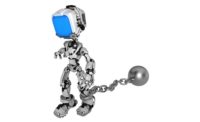Don’t Fear AI; Use It to Improve Manufacturing

Haier is using AI, digital twins and other cutting-edge technologies to reduce defects, increase productivity, and lower costs.
Photo courtesy Haier Group
Like many new technologies, AI has been prone to overhype, misunderstanding, misappropriation and even fear.
According to a May 16 Reuters-Ipsos poll of 4,415 U.S. adults, 61 percent believe that AI could threaten the future of civilization, and more than two-thirds are worried about AI’s negative consequences. The poll also found that three times as many people “foresee adverse outcomes” from AI than those who do not.
A June survey by the Pew Research Center obtained similar results. It found that 52 percent of Americans are more concerned than excited about the increased use of AI, while only 10 percent are more excited than concerned. The share of Americans who are mostly concerned about AI in daily life is up 14 percentage points since December 2022, when 38 percent expressed this view.
To be fair, there is some reason for concern. For example, as a journalist, I find the use of AI to create “deepfake” audio and video segments particularly alarming. On the other hand, I don’t believe that I will—or can—be replaced by ChatGPT.
For manufacturers, there is plenty to like about AI.
For example, generative design software is promising to transform the design process. The technology is streamlining the iteration process, enabling engineers to create viable designs in hours or days instead of weeks or months. The technology can be applied to more than just mechanical designs. Recently, materials research company Materials Nexus used AI to develop a new permanent magnet that does not contain rare earth elements—and did so in a fraction of the time that would have been needed with a traditional iterative laboratory process.
AI and machine learning have long been applied to vision systems to improve automated inspection. For example, an automotive supplier is using the technology to detect defects in car seats with 99 percent accuracy. Another automotive supplier uses AI-based vision to find chips, defects and broken edges on spark plugs.
The benefits of AI in manufacturing are apparent in the latest class of “lighthouse” manufacturing facilities announced by the World Economic Forum and consulting firm McKinsey & Co. in December 2023. Lighthouse facilities are chosen for successfully implementing state-of-the-art production technology in ways that drive financial and operational results. Each facility—there are now 153 of them worldwide—is intended to serve as a beacon of innovation in 21st century manufacturing.
One lighthouse factory, CITIC Pacific Special Steel, a specialty steel manufacturer in Jiangyin, China, deploys AI to optimize the performance of its blast furnace, rolling and cooling processes. As a result, the company has increased throughput by 15 percent, reduced energy consumption by 11 percent, and lowered its nonqualified product rate by 47 percent.
Another lighthouse factory, Haier Group’s assembly plant in Hefei, China, applies AI, digital twins, knowledge graphs and other cutting-edge technologies in the research and development, production and testing of household air conditioners, resulting in a 33 percent increase in energy efficiency, a 58 percent drop in the defect rate, a 49 percent increase in labor productivity, and a 22 percent drop in unit manufacturing costs.
And, at the Ingrasys electronics assembly plant in Taoyuan, Taiwan, engineers deployed an AI-demand forecasting model that is trained on past data. In just three years, the new model increased forecast accuracy by 27 percent.
These examples clearly demonstrate that manufacturers should not fear AI, but embrace it.Looking for a reprint of this article?
From high-res PDFs to custom plaques, order your copy today!






